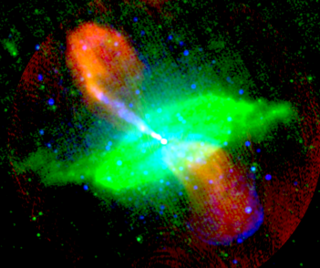
Extragalactic astronomy is the branch of astronomy concerned with objects outside the Milky Way galaxy. In other words, it is the study of all astronomical objects which are not covered by galactic astronomy.

3C 273 is a quasar located in the constellation of Virgo. It was the first quasar ever to be identified.

Radio galaxies and their relatives, radio-loud quasars and blazars, are types of active galactic nuclei that are very luminous at radio wavelengths, with luminosities up to 1039 W between 10 MHz and 100 GHz. The radio emission is due to the synchrotron process. The observed structure in radio emission is determined by the interaction between twin jets and the external medium, modified by the effects of relativistic beaming. The host galaxies are almost exclusively large elliptical galaxies. Radio-loud active galaxies can be detected at large distances, making them valuable tools for observational cosmology. Recently, much work has been done on the effects of these objects on the intergalactic medium, particularly in galaxy groups and clusters.

3C 279 is an optically violent variable quasar (OVV), which is known in the astronomical community for its variations in the visible, radio, and x-ray bands. The quasar was observed to have undergone a period of extreme activity from 1987 until 1991. The Rosemary Hill Observatory (RHO) started observing 3C 279 in 1971, the object was further observed by the Compton Gamma Ray Observatory in 1991, when it was unexpectedly discovered to be one of the brightest gamma ray objects in the sky. It is also one of the brightest and most variable sources in the gamma ray sky monitored by the Fermi Space Telescope. It was used as a calibrator source for Event Horizon Telescope observations of M87* that resulted in the first image of a black hole.

This article is on the astronomer John Bolton. For other people named "John Bolton," see John Bolton (disambiguation).
An astronomical radio source is an object in outer space that emits strong radio waves. Radio emission comes from a wide variety of sources. Such objects are among the most extreme and energetic physical processes in the universe.

Cygnus A (3C 405) is a radio galaxy, and one of the strongest radio sources in the sky. It was discovered by Grote Reber in 1939. In 1951, Cygnus A, along with Cassiopeia A, and Puppis A were the first "radio stars" identified with an optical source. Of these, Cygnus A became the first radio galaxy; the other two being nebulae inside the Milky Way. In 1953 Roger Jennison and M K Das Gupta showed it to be a double source. Like all radio galaxies, it contains an active galactic nucleus. The supermassive black hole at the core has a mass of (2.5±0.7)×109 M☉.
3C 9 is a lobe-dominated quasar located in the constellation Pisces.
3C 191 is a quasar located in the constellation Cancer.

NGC 383 is a double radio galaxy with a quasar-like appearance located in the constellation Pisces. It is listed in Halton C. Arp's 1966 "The Arp Atlas of Peculiar Galaxies." Recent discoveries by the National Radio Astronomy Observatory in 2006 reveal that NGC 383 is being bisected by high energy relativistic electrons traveling at relatively high fractions of the speed of light. These relativistic electrons are detected as synchrotron radiation in the x-ray and radio wavelengths. The focus of this intense energy is the galactic center of NGC 383. The relativistic electron jets detected as synchrotron radiation extend for several thousand parsecs and then appear to dissipate at the ends in the form of streamers or filaments.
3C 35 is a giant Radio galaxy with an active galactic nucleus (AGN). It is classified as a Fanaroff & Riley type II radio galaxy. It is located in the constellation Cassiopeia.
3C 79 is a Seyfert Galaxy located in the constellation Aries. The extended emission-line region (EELR) is almost certainly photoionized by the hidden quasar.
3C 215 is a Seyfert galaxy/Quasar located in the constellation Cancer.
3C 219 is a Seyfert galaxy with a quasar-like appearance located in the constellation Ursa Major. This galaxy's radio jets are not detectable between the core and the outer radio lobes.
3C 299 is a radio galaxy/quasar located in the constellation Boötes.
X-shapedradio galaxies are a class of extragalactic radio source that exhibit two, low-surface-brightness radio lobes oriented at an angle to the active, or high-surface-brightness, lobes. Both sets of lobes pass symmetrically through the center of the elliptical galaxy that is the source of the lobes, giving the radio galaxy an X-shaped morphology as seen on radio maps.
An extragalactic planet, also known as an extragalactic exoplanet, is a star-bound planet or rogue planet located outside of the Milky Way Galaxy. Due to the huge distances to such worlds, they would be very hard to detect directly. However, indirect evidence suggests that such planets may exist. Nonetheless, the most distant known planets are SWEEPS-11 and SWEEPS-04, located in Sagittarius, approximately 27,710 light-years from the Sun, while the Milky Way is between 100,000 and 180,000 light years in diameter. This means that even galactic planets located farther than that distance have not been detected.

3C 147 (B0538+498) is a compact steep-spectrum (CSS) quasar that was discovered in 1964. It is located in the constellation Auriga not far in the sky from the 5th magnitude star Omicron Aurigae.
The Fanaroff–Riley classification is a scheme created by B.L. Fanaroff and J.M. Riley in 1974, which is used to distinguish radio galaxies with active nuclei based on their radio luminosity or brightness of their radio emissions in relation to their hosting environment. Fanaroff and Riley noticed that the relative positions high/low surface brightness regions in the lobes of extragalactic radio sources are correlated with their radio luminosity. Their conclusion was based on a set of 57 radio galaxies and quasars that were clearly resolved at 1.4 GHz or 5 GHz into two or more components. Fanaroff and Riley divided this sample into two classes using the ratio of the distance between the regions of highest surface brightness on opposite sides of the central galaxy or quasar to the total extent of the source up to the lowest brightness contour. Class I are sources whose luminosity decreases as the distance from the central galaxy or quasar host increase, while Class II (FR-II) sources exhibit increasing luminosity in the lobes. This distinction is important because it presents a direct link between the galaxy's luminosity and the way in which energy is transported from the central region and converted to radio emission in the outer parts.

Vijay Kumar Kapahi was an Indian astrophysicist and the director of the National Centre for Radio Astrophysics, an autonomous division of Tata Institute of Fundamental Research. Known for his research on radio galaxies, quasars and observational cosmology, Kapahi was an elected fellow of all the three major Indian science academies – Indian Academy of Sciences, Indian National Science Academy and National Academy of Sciences, India – as well as of the Maharashtra Academy of Sciences. The Council of Scientific and Industrial Research, the apex agency of the Government of India for scientific research, awarded him the Shanti Swarup Bhatnagar Prize for Science and Technology for his contributions to physical sciences in 1987.









